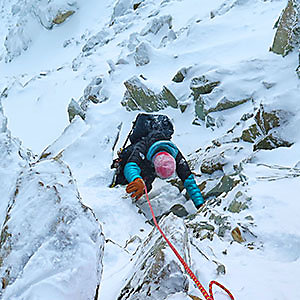Over the past 40 years or so, we’ve built up a pretty hefty product archive. We frequently open it up for inspiration, raiding it for ideas. And over the years we’ve been lucky enough to create some true icons – gear and clothing created in the mountains, developed for alpinists, explorers and boundary-pushers, worn on expeditions that have expanded the realm of what we thought possible. Some of these icons have now found a new home within our limited-edition Seven Summits collection, a head-to-toe range of mountain-inspired streetwear. “We knew from an early stage that we wanted to keep the original intent of the garments and not dilute their functionality. There’s zero compromise on authenticity,” explains TNF design director, Darren Shooter. The story could stop there, and it’d be enough. But this isn’t your standard ‘reborn icons’ collection. It’s uniquely rooted in mountain expedition heritage. And its backstory is one you’ll want to know more about.

The Challenge
The Seven Summits is a
challenge first completed by Dick Bass in 1985. The goal is to
summit the highest mountain on each of the seven continents – and
each mountain poses a unique array of challenges from extreme cold
to extreme altitude. You’d think this’d be enough of an undertaking
for any mountaineer; but in the true spirit of exploration The North Face
®
ski-mountaineer athlete,
Kit DesLauriers, wanted to go a step further. “When I read Dick
Bass’s story, I couldn’t help but visualise those mountains and his
climbs of them. And it became my version of ‘what if?’ What if I
could climb and ski them and travel around the world?” That
hypothetical ‘what if’ became a reality in 2006, when Kit became the
first person to ski the Seven Summits.


The Journey
The quest took Kit two years. It pushed her to her limits and expanded the size of her comfort zone. The training was long and arduous. “I’d do big traverses here in the Tetons (where Kit lives) and each week I’d step up my commitment so that I’d be doing 14- to 16-hour days linking up several peaks and doing it with fewer luxuries of gear, food and water.” This preparation, both in terms of physical and mental preparedness, got Kit through the tougher moments on the mountains.
The Mountain
“There was a moment at Camp 2 (on Everest) where I really questioned myself. The jet stream was howling above us. It was really cold and the days were short. We were waiting for a weather window that showed no sign of coming. I knew I had to relax and accept that every day was as it was supposed to be. There was this juxtaposition between the detachment from the outcome but at the same time a complete commitment to the point where it was very easy to say: ‘who knows if we’re going to make it back down alive’.” Kit had been practicing a concept of detachment in order to not get too caught up in the stress around the outcome – successful or not. “At the same time,” she explained, “we were totally committed to the effort and did everything possible to work towards success.”
This mental strength is arguably one of the reasons everybody got down alive from Everest’s summit. While preparing to ski the Hillary Step, Kit’s husband, Rob, ran out of oxygen. The team went into rescue mode and descended mostly on foot to Camp 4 before nightfall. "It’s actually an easy decision to make in the moment, as nothing is worth risking human life,” said Kit.
The Choice
After spending an uncomfortable second night in the death zone, 8,000m above sea level, Kit, Rob and expedition teammate, Jimmy Chin, decided to go ahead with their original plan to ski the South Pillar, an incredibly steep, exposed route down the Lhotse Face.
“The three of us trusted ourselves and each other. We had complete confidence in discerning our abilities in that moment. I’d asked Rob the day before what he wanted to do. His reply was clear. ‘This is what I want to do. I can do this.’ That was enough for me.”
The South Pillar route is an uninterrupted fall line of 1,500m, with 50 degrees or more of steepness and without a single place for a rest. There was no margin for error and no hope of rescue. “It was the steepest, most intense and committing ski descent that any one of us has ever made.” To put it into perspective, the route is still unridden 13 years later.
The success
Crossing the bergschund at the bottom of the Lhotse Face, Kit knew she had set a new world record and expanded what we all thought possible. But there was a more personal meaning in her achievement. “The reason for skiing the Seven Summits was to get back to that root of who I am and where I find the greatest satisfaction. I think that we need to do what makes our hearts sing if we want to positively contribute to this world.”
Our Seven Summits collection pays homage to Kit’s bold achievements and brings mountain functionality to the city. “Whether worn on summits or streets,” says Darren, “the essence of the Seven Summits collection is to empower exploration.”
The collection is available in selected stores throughout Europe.






